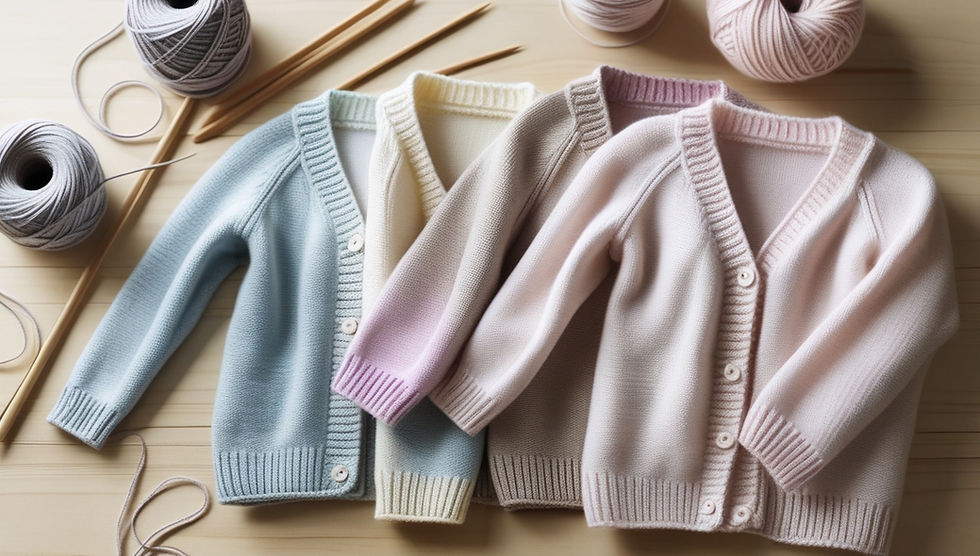The Best Way to Use a Men’s Blazer Size Chart (USA) for Online Shopping
- yhknits
- Jul 17
- 4 min read

When shopping online for a blazer, nothing is more frustrating than receiving a piece that doesn’t fit right. Unlike T-shirts or casual wear, blazers need to fit perfectly to enhance your look and feel comfortable. If you’re buying online, a men’s blazer size chart (USA) is your best friend. But how do you use it effectively to avoid returns and disappointments? In this guide, we’ll explain everything you need to know about blazer sizing in the USA, how to take accurate measurements, and tips for selecting the perfect fit when shopping online.
Why the Right Blazer Fit Matters
A blazer is a classic wardrobe essential, whether for work, business meetings, or special occasions. But wearing a blazer that’s too tight or too loose can ruin your entire look.
✔ A well-fitted blazer sharpens your silhouette.
✔ It adds sophistication to casual outfits.
✔ It boosts your confidence by giving a polished appearance.
The key to this perfect fit? Using a men’s blazer size chart correctly.
Understanding Men’s Blazer Sizes in the USA
Before diving into size charts, you need to understand how blazer sizing works in the USA.
Chest Measurement (Main Indicator):Blazer sizes in the USA are usually based on chest circumference in inches. For example, if your chest measures 40 inches, you’ll likely wear a size 40 blazer.
Length (Short, Regular, Long):Apart from chest size, blazers are categorized into three lengths:
S (Short): For men under 5’7"
R (Regular): For men between 5’8" and 6’0"
L (Long): For men over 6’1"
Fit Type:Blazers come in different cuts: slim fit, classic fit, and modern fit. Your choice depends on personal style and body type.
A Standard Men’s Blazer Size Chart (USA)
Here’s a quick reference for common USA blazer sizes:
Blazer Size | Chest (inches) | Waist (inches) | Height Recommendation |
36 | 36 – 37 | 30 – 31 | 5’6" – 5’8" (S/R) |
38 | 38 – 39 | 32 – 33 | 5’7" – 5’9" (R) |
40 | 40 – 41 | 34 – 35 | 5’8" – 6’0" (R) |
42 | 42 – 43 | 36 – 37 | 5’9" – 6’1" (R/L) |
44 | 44 – 45 | 38 – 39 | 6’0" – 6’2" (L) |
46 | 46 – 47 | 40 – 41 | 6’1" – 6’3" (L) |
48 | 48 – 49 | 42 – 43 | 6’2" – 6’4" (L) |
(Note: Size charts can vary slightly by brand, so always check the one provided by the retailer.)
How to Measure Yourself for a Perfect Blazer Fit
Before buying online, grab a measuring tape and follow these steps:
1. Measure Your Chest
Stand naturally with your arms relaxed.
Wrap the measuring tape around the fullest part of your chest, under your armpits.
Ensure the tape is snug but not tight.
2. Measure Your Shoulders
Measure from one shoulder’s edge to the other across your back.
This helps in choosing the right shoulder fit—blazers should sit flat and not droop.
3. Measure Your Sleeve Length
Bend your arm slightly.
Measure from the edge of your shoulder down to your wrist bone.
Blazer sleeves should show about half an inch of your shirt cuff.
4. Measure Your Waist
Measure around your natural waistline (above the hips).
Compare with the waist size listed in the chart to ensure a comfortable fit.
5. Measure Your Height
This determines whether you need a Short (S), Regular (R), or Long (L) length blazer
How to Use the Size Chart Effectively for Online Shopping
Now that you have your measurements, here’s how to make the size chart work for you:
1. Match Chest Size First
Always start with chest measurement, as it determines your primary blazer size. If you’re between sizes, choose the larger one for easier alterations.
2. Check the Length Option
Pick S, R, or L based on your height. A wrong length can make the blazer look oversized or too cropped.
3. Consider the Fit Style
Look for slim, modern, or classic fit descriptions. Slim fits are closer to the body, while classic fits offer more room.
4. Read the Brand’s Specific Chart
Each brand might have minor differences in sizing. Always check the retailer’s own chart instead of relying solely on a generic one.
5. Read Customer Reviews
Many customers mention whether a blazer runs large or small. Use this feedback to adjust your choice.
6. Double-Check Return Policies
Even with perfect measurements, sometimes the fit can vary. Ensure the online store allows easy returns or exchanges.
Common Sizing Mistakes to Avoid
Guessing Your Size: Never assume your blazer size based on your shirt size.
Ignoring Shoulder Fit: Shoulders are the hardest area to alter; choose wisely.
Forgetting to Check Sleeve Length: Too long or too short sleeves can ruin the overall look.
Not Considering Layering: If you plan to wear the blazer over thick shirts or sweaters, size up slightly.
Blazer Fit Tips for Different Body Types
Tall & Slim: Opt for slim or modern fit with longer lengths.
Short & Stocky: Choose regular lengths with structured shoulders to elongate your frame.
Broad Shoulders: Go for classic fit for comfort and movement.
Conclusion
Shopping for blazers online can be tricky, but once you understand how to use a men’s blazer size chart (USA) effectively, it becomes much easier. Accurate measurements, understanding fit types, and checking brand-specific charts will help you find the perfect blazer without the hassle of returns. A well-fitted blazer isn’t just clothing—it’s a statement of style and confidence.
So next time you’re browsing online, take a few minutes to measure yourself, compare with the size chart, and shop smartly. Your perfect blazer is just a click away!





Comments